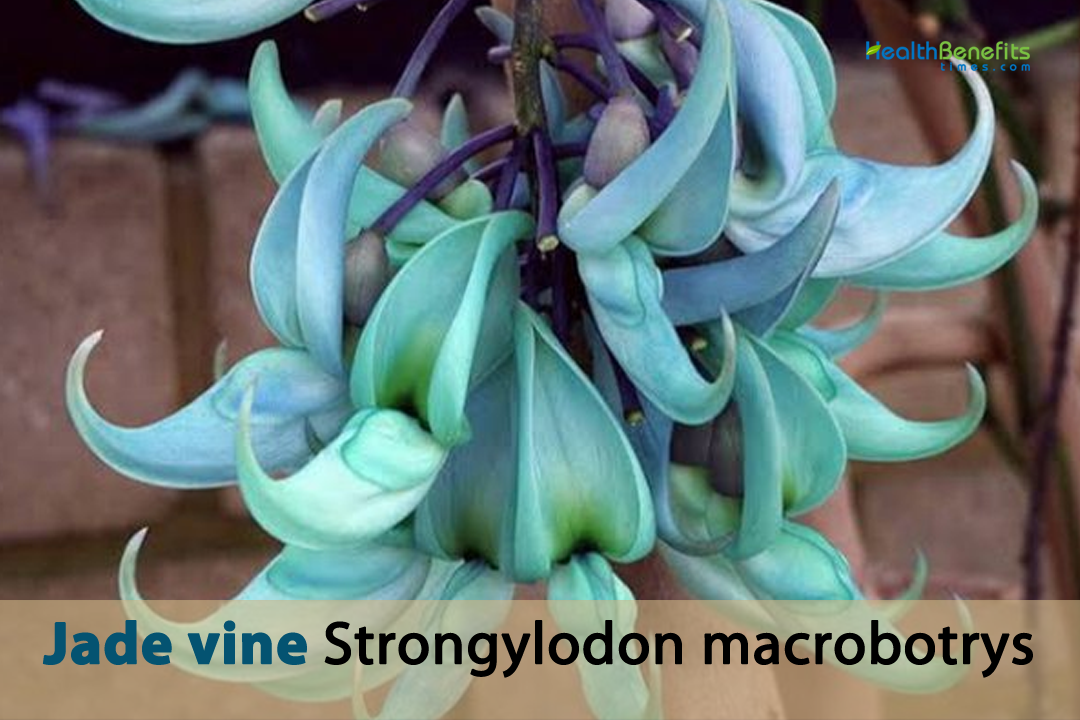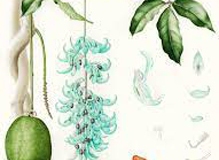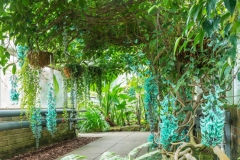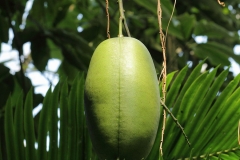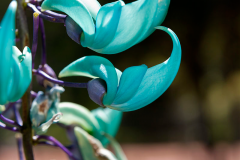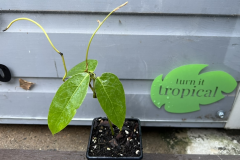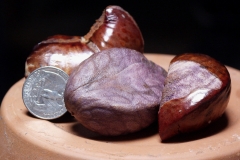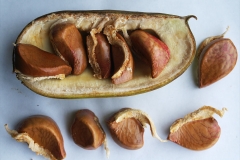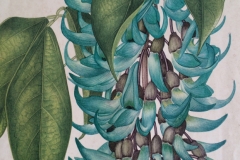Strongylodon is the name of the genus. It comes from the Greek words “o” (strogghilos), which means “rounded,” and “” (odus), which means “tooth,” referring to the rounded lobes of the calyx. The species name, macrobotrys, comes from the Greek words “” (macrs), which means “long,” and “” (btrys), which means “cluster,” referring to the long flower of the plant. Strongylodon macrobotrys is a highly sought-after plant among collectors and fans because its flowers are unique and beautiful. It is easy to recognize as one of the most beautiful flowering plants in the world because of its bright green-blue flowers.
Jade Vine Facts
| Jade vine Quick Facts | |
|---|---|
| Name: | Jade vine |
| Scientific Name: | Strongylodon macrobotrys |
| Origin | Tropical forests of the Philippines (Catanduanes, Luzon and Mindoro) |
| Shapes | Ovate-oblong legumes, 10-13 cm long and of 6 cm of diameter |
| Health benefits | Antioxidant properties, Anti-inflammatory effects, Immune system support, Skin health |
| Name | Jade vine |
|---|---|
| Scientific Name | Strongylodon macrobotrys |
| Native | Tropical forests of the Philippines (Catanduanes, Luzon and Mindoro) |
| Common Names | Blue jade vine, turquoise jade vine, emerald creeper, jade vine, jade climber, Gray’s jade vine, emerald vine |
| Name in Other Languages | Chinese: Lu yu teng (绿玉藤), Fěicuì gé (翡翠葛) Croatian: Žadova loza English: Emerald creeper, Emerald vine, Jade vine, Turquoise jade vine French: Liane de jade, cascade de jade German: Jade-Wein Italian: Fiore di giada, liana di giada Japanese: Hisui kazura (ヒスイカズラ), Makurobotorisu (マクロボトリス) Sutorongirodon makurobotorisu Malayalam: Strongilodon maakrobotris (സ്ട്രോംഗിലോഡോൺ മാക്രോബോട്രിസ്) Portuguese: Flor-de-jade, trepadeira-filipina, trepadeira-jade, Jade-azul Russian: Izumrudnaya liana (Изумрудная лиана), Nefritovaia liana (Нефритовая лиана), Strongilodon krupnokistevoj (Стронгилодон крупнокистевой) Spanish: Cascada de jade, Flor de Jade, parra de jade, parra esmeralda, parra de jade turquesa Swedish: Jadevin Tagalog: Bayou, Tapayac, Tayabak Thai: Phwngh̄yk (พวงหยก) Vietnamese: Móng cọp xanh |
| Plant Growth Habit | Woody, stunning, tropical, evergreen climbers |
| Growing Climates | Wild in damp forests, pluvial forests beside water streams or ravines |
| Soil | Fertile, well-draining soil that is slightly acidic to neutral |
| Plant Size | Reach 12-18 m of length with stems up to 3 cm and even more of diameter |
| Stem | Strong, gray-brown, woody stem that can grow as long as 18 meters, |
| Leaf | Leaves are alternate, trifoliate, with oblong-ovate coriaceous leaflets with thinned apex and entire margin, 7-12 cm long, of dark brown color when young, then glossy dark green |
| Flowering season | January August September October November December |
| Flower | Flowers vary from blue-green to mint green in color, similar to colors of minerals like turquoise and jade |
| Fruit Shape & Size | Fruits are ovate-oblong legumes, 10-13 cm long and of 6 cm of diameter, containing 6-12 reniform brown, 3-4 cm long, seeds |
| Propagation | By seeds, cuttings, or air-layering |
| Health benefits |
|
Plant Description
The jade vine is a gorgeous tropical plant that can grow up to 18 meters long and has stems that can be more than 3 cm wide. Its woody texture adds to its beauty, and it often grows wild in damp woods, near water streams, or on cliffs and rocks. This beautiful plant needs soil that is rich, drains well, and is slightly acidic to neutral in pH. It also needs to be watered regularly, especially during the growing season. The jade vine can easily climb up trees, walls, or any other strong structure close because its stem and tendrils are strong. The jade vine is a great addition to any yard or landscape because it is both beautiful and hardy.
Stem
The Jade vine has a strong, gray-brown, woody stem that can grow as long as 18 meters, which is very amazing. It has branches that wrap around nearby support structures to strengthen its stem. This makes it easy for it to climb trees or walls. The Jade vine is able to get a strong foothold and grow up easily because it has a natural way to hold itself in place. Its tough stem and strong branches make it a tough plant that can grow well in many different places.
Leaves
The leaves of this plant are beautiful not only because they are big, but also because they are complicated. These leaves are complex, which means they have more than one leaflet. They can have anywhere from 5 to 13 leaflets and can be up to 30 cm long. Each oval-shaped leaflet, which can grow up to 15 cm long, has a shiny surface and a deep green color. This adds to its beauty. The pointy end of each sheet makes it look even more elegant. The way these leaflets are arranged along the stem and connected to a single stalk makes for a beautiful effect. The plant’s twining growth pattern is also interesting. It uses its tendrils to wrap around and climb nearby trees or trellises in a very beautiful way. This not only makes it look nicer, but also makes it a fun plant to look at and take care of.
Flower
Strongylodon macrobotrys is beautiful because it has stunning flowers that will stay with you for a long time. These flowers grow in long, drooping groups that can be up to 90 cm long. Each cluster has 75 individual flowers, which is a lot. The flowers are shaped like curved tubes that are about 7 cm long. This makes them even more special. Their beautiful color, which runs from pale green to blue-green, is what really makes them stand out. This beautiful color comes from a pigment called quercetin that is found in the cell walls of the flowers. This is a very rare thing to see in nature. The flowers are joined at the bottom and end in a sharp point, which adds to their beauty.
These beautiful flowers bloom from late spring to early summer, and both bats and bees help spread their pollen. These pollinators are attracted to the honey that the plant makes, and the shape of the flower makes it easy for them to get to the nectar. It’s hard not to be drawn in by the beauty of these flowers, and they are sure to be the star of any yard or flower arrangement.
Fruits
The unique seedpods of the jade vine are another thing that makes this plant stand out. These short, ovate-oblong, thick seedpods can grow up to 10-15 cm long and 6 cm wide. They have 6–12 brown seeds that look like rhombs and are about 3–4 cm long. The form and color of the seedpods make them an interesting addition to any collection of plant parts.
In the wild, bats fertilize the jade vine. This means that it must be hand-pollinated in greenhouses in order to make fruit. With care and attention, these fruits can grow to the size of melons, which is a real wonder to see. The Royal Botanic Gardens at Kew Gardens in England have been very helpful in this effort. They have ongoing programs to save seeds that aim to keep this plant species alive even though jungle habitats are being destroyed. The jade vine is a beautiful plant that should be taken care of. Its unusual seedpods and need to be pollinated by hand make it even more interesting.
History
Strongylodon macrobotrys has a long and interesting past that goes back to the late 1800s, when botanist George H. L. Samar found it in the Philippines’ remote rainforests. Samar helped get the first pieces of the plant to the Royal Botanic Gardens at Kew in London, where the well-known botanist William Botting Hemsley studied and wrote about them.
Strongylodon macrobotrys is now a well-known name among both botanists and gardeners. Its beautiful look has won over the hearts of many. Because of how unique and interesting it is, it is a very popular ornamental plant in botanical parks and private collections all over the world. It’s not surprising that people who like nature for its beauty and rarity like it so much.
Health benefits of Jade Vine
The beautiful blue flowers of the jade vine are what make this plant so well-known. Even though there isn’t much scientific study on jade vine’s health benefits, it is thought to have a number of possible benefits.
1. Antioxidant properties
We are always amazed by the things that God made. One of these amazing things is the Jade plant, which is full of flavonoids, which are powerful antioxidants that can protect our cells from the harmful effects of oxidative stress. Not only may that, but the flavonoids in jade vine also lower the chance of chronic diseases like cancer and heart disease, which are becoming more common. With so many great health benefits, it’s clear that everyone should eat jade vine every day. So why hold out? Start eating jade vine today and take the first step toward a healthier, happy life.
2. Anti-inflammatory effects
It’s interesting to learn that some of the chemicals in the jade vine plant may help reduce inflammation. This finding is very exciting because it suggests that jade vine could help ease the symptoms of inflammatory diseases like arthritis by reducing inflammation in the body. Several studies have pointed to this exciting possibility, which makes it possible for more study to be done on the possible health benefits of jade vine. Adding jade plant to your diet could be a good place to start if you want a natural way to deal with inflammation.
3. Immune system support
It’s amazing to learn that the jade vine plant has a lot of chemicals that boost the immune system. These compounds might do a lot to improve general health and lower the risk of getting sick by making the immune system stronger. Studies have shown that jade vine can help strengthen your immune system. This makes it a natural way to help your body fight off diseases. Adding jade vine to your food could be a good way to become healthier and stronger.
4. Skin health
Jade vine is a herb that is often used in traditional medicine. It has strong qualities that have been shown to help improve skin health and reduce common skin problems like acne and eczema. Adding this natural remedy to your skin care routine can help you get a flawless, glowing face that makes you feel beautiful and confident. Jade vine may be the answer you’ve been looking for to solve your skin problems because it works well and doesn’t have any dangerous chemicals. So why not give this natural cure a try and see for yourself what a difference it makes?
Traditional uses and benefits of Jade Vine
- The Jade Vine has a long past of medicinal use in traditional Philippine medicine.
- It has been utilized to treat a sort of ailments like skin diseases, headache and fever.
- Leaves and flowers of the Jade Vine consist of flavonoids and alkaloids that have analgesic and anti-inflammatory properties.
- Plant is used to treat rheumatism, fever, skin diseases and numerous other disorders.
- Roots and leaves have been used in traditional medicine for their curative properties.
Culinary Uses
- In certain parts of the Philippines, young leaves and flowers are often consumed as a veggie.
- They are used in several dishes like salads, stews and soups.
- Flowers and leaves are rich in nutrients and have a distinctive taste.
Symbolism of Jade vine
Love and Affection
Philippine folklore says that the Jade Vine is important when it comes to love and respect. People think that the beautiful blue-green color of the plant represents a deep, long-lasting love that can get through anything. Because of this, the jade vine has become a popular choice for romantic actions and gifts because it shows how deep and sincere one’s feelings are. Whether you want to tell someone you love them or just enjoy the beauty and meaning of this popular plant, the Jade Vine is a classic and enchanting choice that will capture the heart and mind.
Rejuvenation and Regeneration
Aside from being a sign of love and respect, the Jade Vine is also seen as a sign of rebirth and renewal. Its unique ability to climb and cover dead trees and rocks shows how powerful the plant is at bringing new life to dead places. Because it is a sign of renewal, the Jade Vine is a popular choice for people who want to change something in their lives or settings. The Jade Vine is a strong reminder of the amazing power to grow and change that is in all of us. It can help you bring new energy into your personal relationships or breathe new life into a stale workplace.
Abundance and Prosperity
According to the rules of Feng Shui, the Jade Vine is a sign that there will be plenty of money and wealth in the home. People think that the plant’s bright and striking color has the power to bring luck and money to its settings. Because of this, the Jade Vine has become a common choice for people who want to improve their financial success or bring more abundance into their lives. The Jade Vine is a beautiful and powerful sign of prosperity and good luck that can help you think more positively about money or make your business ventures more profitable and successful.
Other Facts
- Jade Vine is a prevalent decorative plant because of its spectacular and exclusive flowers.
- It is extensively grown as ornamental plants in parks, gardens, conservatories and public places as a central point.
- It can be grown within the house as a houseplant with the suitable care.
- The plant is considered a symbol of love and dedication and is frequently included in traditional poetry and songs in Philippines.
- The plant is used in numerous cultural events like religious ceremonies and weddings, to symbolize success and good luck.
References:
https://www.missouribotanicalgarden.org/PlantFinder/PlantFinderDetails.aspx?taxonid=280642
https://gd.eppo.int/taxon/SGOMA
https://en.wikipedia.org/wiki/Strongylodon_macrobotrys
http://www.theplantlist.org/tpl1.1/record/ild-30839
http://www.stuartxchange.com/Tayabak
http://creationwiki.org/Jade_vine


